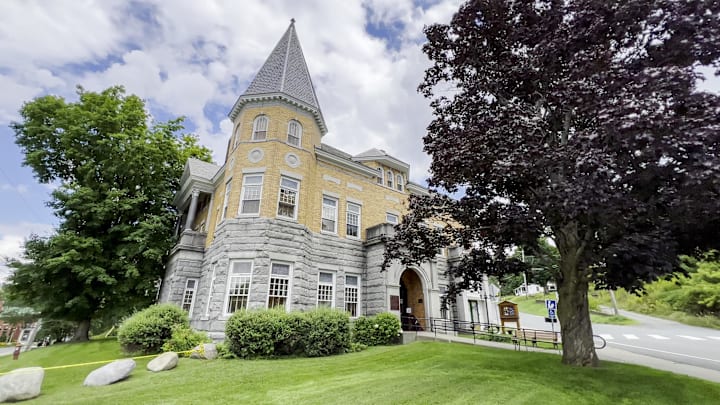Though the Haskell Free Library and Opera House might not be as well known as the Grand Canyon or the Statue of Liberty, it’s undoubtedly one of America’s most unique tourist attractions. Completed in 1904, the building is stationed directly between Stanstead, Quebec, and Derby Line, Vermont, with the official U.S.-Canada borderline running right across the library’s floor.
The Haskell is divided between the two countries. While the library’s main entrance is on the U.S. side of the building, most of the books are on the Canadian side. The opera house is similarly split, with most of its seats in the U.S. and its stage in Canada. As Atlas Obscura reported, it is often said that the Haskell is the only library in the U.S. with no books, and the only opera house in the country with no stage.
For decades, the building was a place where those from either side of the border could easily mingle. Both Americans and Canadians were able to pass through the library’s main entrance (those coming from Canada just had to walk down the sidewalk to reach the entrance). But that’s now changing. As of March 2025, Americans and Canadians with a library membership can use the main door; those coming from Canada without a library card must use a side entrance located on the Canadian side of the border. By October 2025, however, all Canadians will be required to use an entrance on their side of the border—regardless of whether they’re members of the library or not.

Passports and other forms of identification aren’t required to cross from country to country once within the library, though the Haskell’s website notes that “both the US Border Patrol and the RCMP have the right to ask to see personal identification and detain anyone who is not of legal status.” Those who wish to enter are encouraged to bring any documentation they would need for a proper border crossing. Visitors are also expected to return to their side of the border after a visit; if they don’t, they risk possible detention and fines.
The library has begun raising funds to build a proper entrance and parking lot in Canada. “For over a century, the Haskell Free Library and Opera House has stood as a powerful symbol of unity and cross-border friendship—one of the only buildings in the world that quite literally connects two nations. “This sudden closure not only limits off Canadian visitors from their shared history, [but it] threatens the very spirit of collaboration that has defined this institution for generations,” a library representative wrote on its GoFundMe. “We refuse to let a border divide what history has built together.”
Read More About Geography:
This article originally ran in 2016; it has been updated for 2025.
